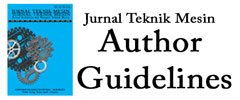Review of Carbon Fiber Based on Physical and Mechanical Properties in Vehicle Frame
DOI:
https://doi.org/10.9744/jtm.22.1.10-18Keywords:
carbon, fibre, mechanical, physical, mechanical propertiesAbstract
This research aims to assess carbon fibre's physical and mechanical properties and potential use to improve vehicle efficiency. The main focus is to reduce vehicle weight, improve fuel efficiency, and lower carbon emissions. Carbon fibre has a tensile strength of more than 6 GPa, a modulus of elasticity of more than 600 GPa, and a density of 1.8-2.0 g/cm³. Its use in vehicles can reduce weight by 86%, improve fuel efficiency by 20%, and significantly reduce carbon emissions. The carbon fibre sandwich composite structure with an aluminium honeycomb core increases strength and reduces weight by 36%. Carbon fibre also improves the vehicle's rollover resistance by 64% and energy absorption by 60%. However, high manufacturing costs are a major challenge, with precursor materials such as polyacrylonitrile (PAN) accounting for about 50% of the cost. Biomass-based alternatives, such as lignin and agricultural waste, can reduce costs, although they require further development. Research shows that integrating recycled carbon fibre in metal-polymer hybrid structures can reduce vehicle weight by 48% and improve structural performance. This research emphasizes the importance of manufacturing innovation and the exploration of alternative materials to maximize the utilization of carbon fibre.
References
S. Ma et al., “Impacts of on-road vehicular emissions on US air quality: A comparison of two mobile emission models (MOVES and FIVE),” Journal of Geophysical Research: Atmospheres, vol. 129, no. 20. 2024. doi: 10.1029/2024JD041494.
J. Salva, M. Vanek, M. Schwarz, M. Gajtanska, P. Tonhauzer, A. Ďuricová, “An assessment of the on-road mobile sources contribution to particulate matter air pollution by aermod dispersion model,” Sustain., vol. 13, no. 22, 2021, doi:10.3390/su132212748.
M. Zimakowska-Laskowska, P. Laskowski, M. K. Wojs, P. Orliński, “Prediction of pollutant emissions in various cases in road transport,” Appl. Sci., vol. 12, no. 23, 2022, doi: 10.3390/app122311975.
A. A. Melbert, T. H. Nguyen, A. V. Mashensky, “Use of fuel injection equipment with increased injection pressure for reducing environmental footprint,” Tractors Agric. Mach., vol. 89, no. 5, pp. 325–331, 2022, doi: 10.17816/0321-4443-108145.
S.P. John, “Automatic engine start-stop and automatic headlight dimming modular system,” Int. J. Eng. Res., vol. V9, no. 07, pp. 334–339, 2020, doi: 10.17577/ijertv9is070155.
M. Bohm, J. Stetina, D. Svida, “Exhaust gas temperature pulsations of a gasoline engine and its stabilization using thermal energy storage system to reduce emissions,” Energies, vol. 15, no. 7, 2022, doi: 10.3390/en15072365.
M. Filippini, N. Kumar, S. Srinivasan, “Nudging the Adoption of Fuel-Efficient Vehicles: Evidence from a Stated Choice Experiment in Nepal,” Econstor, no. May, 2020
F. Hermansson, S. Heimersson, M. Janssen, M. Svanström, “Can carbon fiber composites have a lower environmental impact than fiberglass?,” Resour. Conserv. Recycl., vol. 181, no. July 2021, 2022, doi: 10.1016/j.resconrec.2022.106234.
H. Ahmad, A. A. Markina, M. V. Porotnikov, F. Ahmad, “A review of carbon fiber materials in automotive industry,” IOP Conf. Ser. Mater. Sci. Eng., vol. 971, no. 3, 2020, doi: 10.1088/1757-899X/971/3/032011.
A. Air, M. Shamsuddoha, E. Oromiehie, B. G. Prusty, “Development of an automated fibre placement-based hybrid composite wheel for a solar-powered car,” Int. J. Adv. Manuf. Technol., vol. 125, no. 9–10, pp. 4083–4097, 2023, doi:10.1007/s00170-023-10946-9.
Q. hua Ma, F. Dong, X. yu Qin, X. hui Gan, M. Cai, “Parallel optimization of design and manufacturing—Carbon fiber battery pack for electric vehicles,” Mech. Adv. Mater. Struct., vol. 31, no. 10, pp. 2289–2306, 2024, doi:10.1080/15376494.2022.2155273.
E. Ramalho et al., “Understanding wind energy economic externalities impacts: a systematic literature review,” Renew. Sustain. Energy Rev., vol. 209, no. March 2024, 2025, doi: 10.1016/j.rser.2024.115120.
P. Morgan, CARBON FIBERS and their Composites. 2005. [Online]. Available: https://www.taylorfrancis.com/books/mono/10.1201/9781420028744/carbon-fibers-composites-peter-morgan
R. S. Havigh & H. M. Chenari, “A comprehensive study on the effect of carbonization temperature on the physical and chemical properties of carbon fibers,” Sci. Rep., vol. 12, no. 1, pp. 1–14, 2022, doi: 10.1038/s41598-022-15085-x.
J. Cao, W. Zhao, S. Gao, “Properties and structure of in situ transformed PAN-based carbon fibers,” Materials (Basel)., vol. 11, no. 6, 2018, doi: 10.3390/ma11061017.
T. Harano et al., “Observation of distribution of π-orbital-oriented domains in PAN- and pitch-based carbon fibers using scanning transmission X-ray microscopy,” Appl. Sci., vol. 10, no. 14, 2020, doi: 10.3390/app10144836.
K. Drechsler, M. Heine, P. Mitschang, “Carbon fiber composites: Carbon fiber reinforced polymers,” Ind. Carbon Graph. Mater. Raw Mater. Prod. Appl. Vol. 1 2, vol. 1–2, no. April, pp. 697–739, 2021, doi: 10.1002/9783527674046.ch12_1.
L. Markovičová, V. Zatkalíková, P. Hanusová, “Carbon fiber polymer composites,” Qual. Prod. Improv. - QPI, vol. 1, no. 1, pp. 276–280, 2019, doi: 10.2478/cqpi-2019-0037.
X. Ma, C. Yuan, X. Liu, “Mechanical, microstructure and surface characterizations of carbon fibers prepared from cellulose after liquefying and curing,” Materials (Basel)., vol. 7, no. 1, pp. 75–84, 2014, doi: 10.3390/ma7010075.
A. M. Khandekar, G. R. Mote, N. S. Vastre, S. A. Mosalgi, S. B. Bhosale, “Study, manufacturing and analysis of conveyor chain pin by using composite material,” Int. J. New Technol. Res., vol. 5, no. 4, pp. 48–50, 2019, doi: 10.31871/ijntr.5.4.24.
D. Li, Y. Feng, F. Li, J. Tang, T. Hua, "Carbon fibers for bioelectrochemical: precursors, bioelectrochemical system, and biosensors", vol. 5, no. 3. Springer Nature Singapore, 2023. doi: 10.1007/s42765-023-00256-w.
J. H. Fonseca et al., “Design and numerical evaluation of recycled-carbon-fiber-reinforced polymer/metal hybrid engine cradle concepts,” Int. J. Mech. Sci., vol. 163, no. July, p. 105115, 2019, doi: 10.1016/j.ijmecsci.2019.105115.
J. Wang, C. Shi, N. Yang, H. Sun, Y. Liu, B. Song, “Strength, stiffness, and panel peeling strength of carbon fiber-reinforced composite sandwich structures with aluminum honeycomb cores for vehicle body,” Compos. Struct., vol. 184, pp. 1189–1196, 2018, doi: 10.1016/j.compstruct.2017.10.038.
D. Semitekolos et al., “Design, manufacturing, and evaluation of race and automotive prototypal components fabricated with modified carbon fibres and resin,” Polymers (Basel)., vol. 16, no. 14, 2024, doi: 10.3390/polym16142062.
W. Yu & L. Jiang, “Application of carbon fiber reinforced aluminum matrix composites in automotive industry,” Int. J. Automot. Manuf. Mater., p. 3, 2024, doi: 10.53941/ijamm.2024.100009.
D. Lavayen-farfán & J. A. Butenegro-garcía, On the use of carbon fiber composites for the enhancement of the rollover resistance of steel buses daniel, vol. 2. Springer International Publishing, 2023. doi: 10.1007/978-3-031-38563-6.
M. S. A. Razak, M. N. Othman, S. N. Sulaiman, R. Ramli, Y. Sanada, “Composite optimization of automotive carbon fiber strut bar using hyperworks optistruct,” J. Phys. Conf. Ser., vol. 1793, no. 1, pp. 0–10, 2021, doi: 10.1088/1742-6596/1793/1/012072.
J. H. Fonseca, L. Quagliato, S. Yun, D. Han, N. Kim, H. Lee, “Preliminary design of an injection-molded recycled-carbon fiber–reinforced plastic/metal hybrid automotive structure via combined optimization techniques,” Struct. Multidiscip. Optim., vol. 64, no. 4, pp. 2773–2788, 2021, doi: 10.1007/s00158-021-02988-y.
V. Papaiya, J. Schuster, Y. P. Shaik, “Development of a side door composite impact beam for the automotive industry,” no. December 2023, 2024, doi: 10.4236/ojcm.2024.141001.
M. Hathcock et al., “Opportunities to improve carbon fiber composites for vehicle lightweighting using graphene additives,” no. April, pp. 1–10, 2018.
J. Čwiek & L. Wierzbicki, “The role of lightweight materials in modern transport vehicles,” Diagnostyka, vol. 23, no. 4, pp. 2–7, 2022, doi: 10.29354/diag/155850.
L. Ma et al., “Structure design of gfrp composite leaf spring: An experimental and finite element analysis,” Polymers (Basel)., vol. 13, no. 8, pp. 1–22, 2021, doi: 10.3390/polym13081193.
P. Dewi Basoeki, “Improving lightweight materials processing for automotive by using intercritical annealing,” MATEC Web Conf., vol. 175, pp. 1–5, 2018, doi: 10.1051/matecconf/201817502023.
M. Kepenekci, B. Gharehpapagh, U. Yaman, S. Özerinç, “Mechanical performance of carbon fiber-reinforced polymer cellular structures manufactured via fused filament fabrication,” Polym. Compos., vol. 44, no. 8, pp. 4654–4668, 2023, doi:10.1002/pc.27429.
G. Kovács, “Optimization of a new composite multicellular plate structure in order to reduce weight,” Polymers (Basel)., vol. 14, no. 15, 2022, doi: 10.3390/polym14153121.
Y. Zhang, C. Yan, X. Huang, Y. Chen, “Structural design and mechanical performance analysis of carbon fiber closed fixtures for uhv transmission lines,” Math. Probl. Eng., vol. 2021, 2021, doi: 10.1155/2021/6105360.
S. J. Mostafavi Yazdi, S. Pack, F. Rouhollahi, J. Baqersad, “A modeling framework to develop materials with improved noise and vibration performance for electric vehicles,” Energies, vol. 16, no. 9, 2023, doi: 10.3390/en16093880.
P. Wu, “Optimized lightweight frame for intelligent new-energy vehicles,” Trends Renew. Energy, vol. 9, no. 2, pp. 157–166, 2023, doi: 10.17737/tre.2023.9.2.00159.
A. Kochov, M. Spasovski, F. Serafimovski, “Tensile strength of carbon fiber,” Teh. Glas., vol. 16, no. 4, pp. 537–541, 2022, doi: 10.31803/tg-20220124094904.
Š. Kender, J. Brezinová, H. Sailer, “Advantages of using composite materials in automotive manufacture process,” Trans Motauto World, vol. 5, no. 1, pp. 3–5, 2020, [Online]. Available: http://www.scribd.com/doc/32475280/Composites-in-the-
A. Garofano, V. Acanfora, F. Fittipaldi, A. Riccio, “On the use of a hybrid metallic-composite design to increase mechanical performance of an automotive chassis,” J. Mater. Eng. Perform., vol. 32, no. 9, pp. 3853–3870, 2023, doi:10.1007/s11665-023-08206-8.
B. Ravi & M. S. Gupta, “Design and development of automotive carbon fiber bracket,” IOP Conf. Ser. Mater. Sci. Eng., vol. 455, no. 1, 2018, doi: 10.1088/1757-899X/455/1/012126.
S. Sudirja, A. Hapid, Amin, S. Kaleg, A. C. Budiman, “Stress analysis simulations of welded and bolted joints method for full steel and composite-steel chassis structure of electric low floor medium bus,” EUREKA, Phys. Eng., vol. 2020, no. 6, pp. 61–70, 2020, doi: 10.21303/2461-4262.2020.001516.
M. Drahansky et al., “The effect of temperature on the mechanical performance of steel and carbon fiber reinforced polymer (CFRP) tensegrity system,” Intech, vol. i, no. tourism, p. 13, 2019, doi: http://dx.doi.org/10.5772/57353.
Z. Zhang, P. Myler, E. Zhou, R. Zhou, “Strength and deformation characteristics of carbon fibre reinforced composite wrapped aluminium foam beams,” J. Compos. Sci., vol. 6, no. 10, 2022, doi: 10.3390/jcs6100288.
T. Röding, J. Langer, T. Modenesi Barbosa, M. Bouhrara, T. Gries, “A review of polyethylene-based carbon fiber manufacturing,” Appl. Res., vol. 1, no. 3, 2022, doi: 10.1002/appl.202100013.
M. T. Islam, M. S. Howlader, D. M. Shuvo, M. K. Uddin, “Carbon fiber from Biomass sources: A Comprehensive Review,” Non-Metallic Mater. Sci., vol. 5, no. 1, pp. 14–26, 2023, doi: 10.30564/nmms.v5i1.5572.
S. M. Yang, M. S. P. Shaffer, A. Brandt-Talbot, “High lignin content carbon fiber precursors wet-spun from low-cost ionic liquid water mixtures,” ACS Sustain. Chem. Eng., vol. 11, no. 24, pp. 8800–8811, 2023, doi: 10.1021/acssuschemeng.3c00234.
A. F. Abou-Hadid et al., “Production of efficient carbon fiber from different solid waste residuals for adsorption of hazardous metals from wastewater samples,” Biomass Convers. Biorefinery, vol. 14, no. 9, pp. 10501–10516, 2024, doi:10.1007/s13399-022-03097-6.
M. Wu, J. Sadhukhan, R. Murphy, U. Bharadwaj, X. Cui, “A novel life cycle assessment and life cycle costing framework for carbon fibre-reinforced composite materials in the aviation industry,” Int. J. Life Cycle Assess., vol. 28, no. 5, pp. 566–589, 2023, doi: 10.1007/s11367-023-02164-y.
S. Singh & R. K. Bhushan, “Additive manufacturing of carbon fiber reinforced composites for medical application: Issues and challenges,” Int. J. Eng. Res. Technol., vol. 7, no. 03, pp. 1–4, 2019
H. H. Ovrebo, S. A. Koldre, O. S. Nesheim, S. W. Eikevåg, M. Steinert, C. W. Elverum, “Creating an open-source, low-cost composite feeder design to improve filament quality of high-performance materials to be used in fused filament fabrication (FFF),” Proc. Des. Soc., vol. 3, no. July, pp. 1097–1106, 2023, doi: 10.1017/pds.2023.110.
E. H. Baalbergen, J. A. De Marchi, R. Klerx, “Unleashing the potentials of digital twinning in the production of composite aircraft components,” J. Phys. Conf. Ser., vol. 2526, no. 1, 2023, doi: 10.1088/1742-6596/2526/1/012046.
Downloads
Published
Issue
Section
License
Copyright (c) 2025 Hafidz Salafuddin, Muhamad Fitri

This work is licensed under a Creative Commons Attribution 4.0 International License.
Jurnal Teknik Mesin is publihed by the Mechanical Engineering Department, Petra Christian University, Indonesia
![]()
All articles and their contents are published and distributed under the international license of Creative Commons Attribution License (CC BY).



















